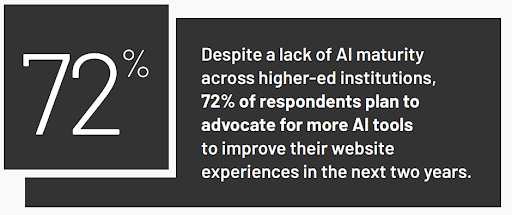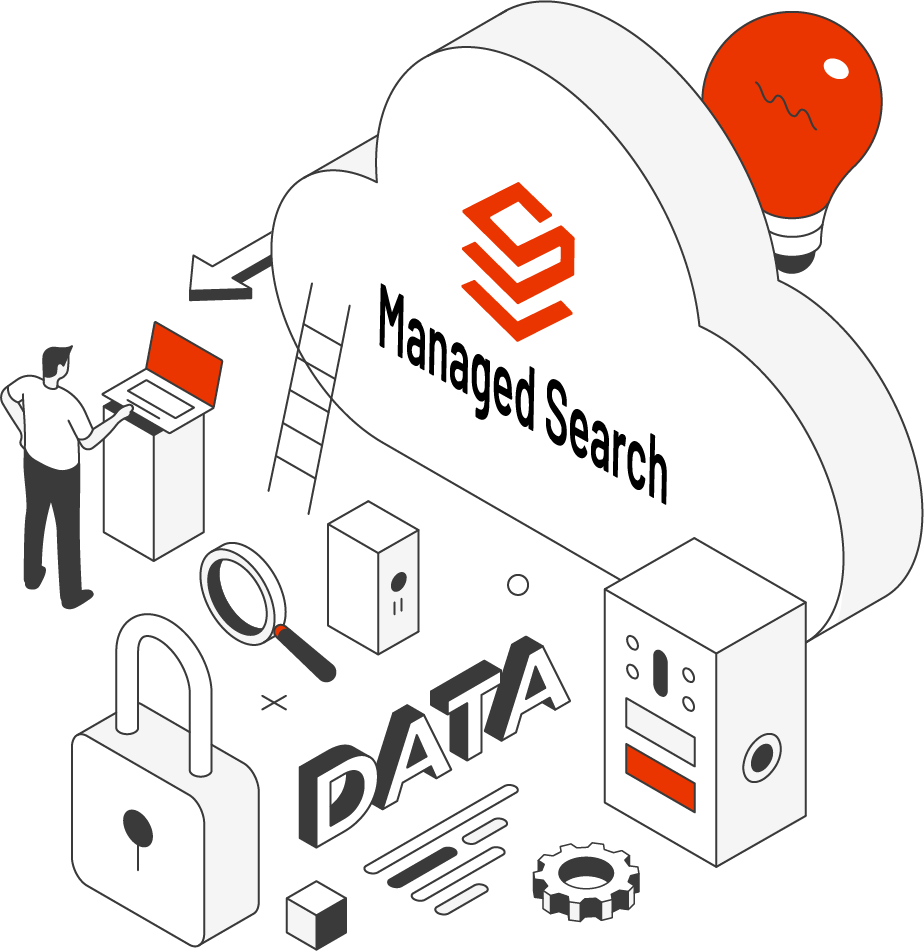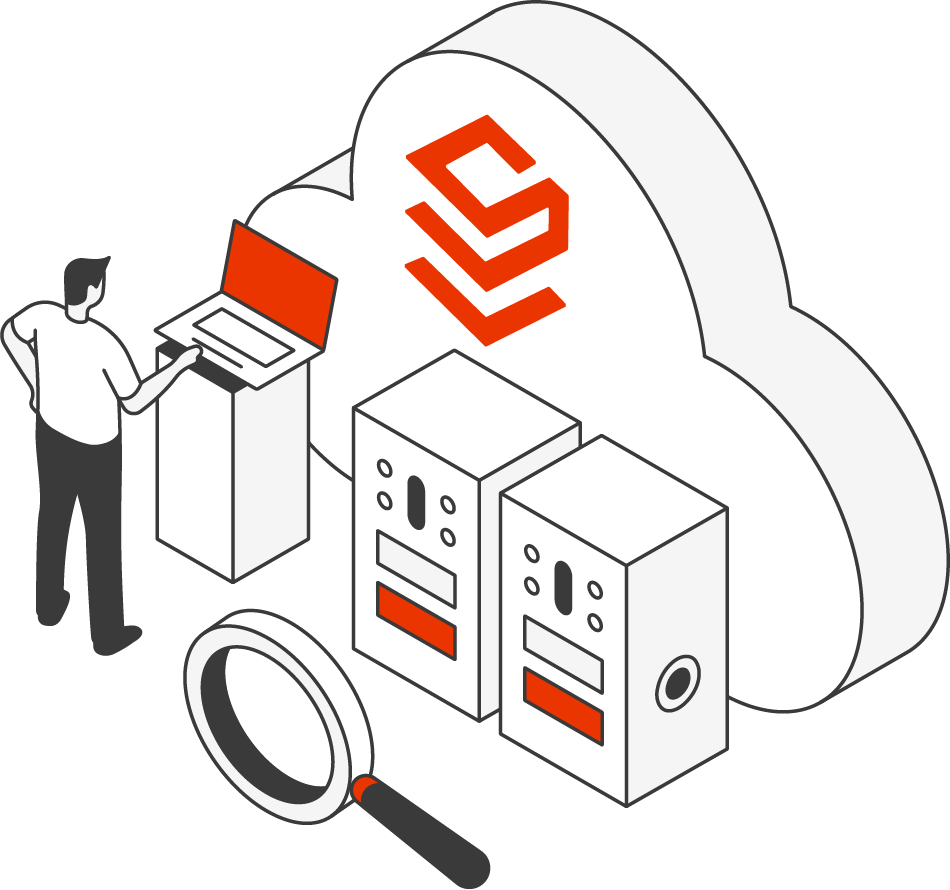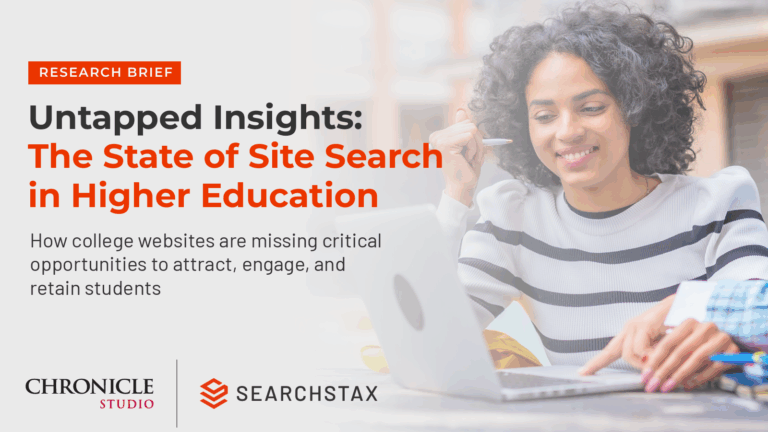June 24, 2025
Jeff Dillon
|
If you’ve ever cringed watching a prospective student dig through your website looking for something obvious, like your application deadline, you already know:
Search matters.
As AI becomes more integrated into how students, parents and internal audiences navigate university websites, there’s a growing belief that it’s here to replace traditional search. That’s not the case. In reality, AI is here to assist site search, not override it.
And for marketers, that means one thing: you’re not just earning a seat at the table anymore, you’re hosting the entire dinner. The future of higher education web experiences depends on marketing leaders taking ownership of the AI search strategy, demanding data access and ensuring institutional voice remains consistent even when AI does the talking.
Higher Ed Search Is a Tug-of-War with Many Audiences
University websites are a digital battleground of audiences, all with different goals and a distinctly different language. Prospective students want answers, not PDFs. Parents want tuition costs, not press releases. Internal staff want links. And faculty? They want everything exactly where it was in 2009.
Consider how differently these audiences approach your site:
- A high school junior searches “film program requirements,” but means “what classes would I take in your cinema and media studies major?”
- A parent types “cost calculator,” but means “will my family qualify for need-based aid?”
- A faculty member searches “committee minutes,” and actually expects to find the exact PDF from March 2021.
Add decentralized content, legacy systems and an org chart that feels more like a family tree, and you’ve got a search challenge that no single tool, AI or otherwise, can solve in isolation.
The Critical Role of User Journeys in Higher Ed Marketing
As marketers, we spend a lot of time refining user journeys, meticulously mapping how prospective students move from awareness to interest to decision. We craft elaborate email nurture sequences. We build landing pages with progressive disclosure. We A/B test call-to-action buttons and create personalized dashboards for admitted students.
For example, at many large universities, marketing teams create detailed journey maps that follow a prospect from their first interaction with a social ad through their application submission, tracking dozens of touchpoints along the way. Some institutions use heat mapping and user testing to understand exactly where prospective graduate students abandon complex application forms.
But if your search bar isn’t pulling its weight, the journey gets abandoned. When a potential nursing student can’t locate your credit equivalency tables, all that journey work goes to waste. A single frustrating search experience can derail months of careful nurturing.
What's Actually Changing with AI in Site Search?
Despite a lack of AI Maturity across higher-ed institutions, 72% of respondents plan to advocate for more AI tools to improve their website experiences in the next two years.

The search shift is moving from keywords to intent. From “10 blue links” to conversational, AI-powered responses.
For example, someone types, “What scholarships are available for out-of-state business majors?” Instead of sending them to your generic financial aid landing page, AI can synthesize info from your catalog, scholarship database and admissions microsite, and return a helpful, conversational answer.
Institutions that use AI to fine-tune the order of search results are seeing a noticeable difference in site search experience. “Average click position is up 37%, and we’ve seen a 16% boost in click-through rate, thanks to AI technology that actually understands the intent behind search queries” says Corey Reed, Director of Web Management at Texas Christian University. Many universities have found that implementing intent-based search increased yield for transfer students by creating clearer pathways to program-specific requirements.
The Technology Behind AI-Assisted Search: Why RAG Matters to Marketers
Behind this shift from keywords to intent lies a crucial technology decision that directly impacts your marketing effectiveness. Enter RAG, a method that fundamentally changes how your content reaches users.
RAG stands for Retrieval-Augmented Generation, a method that lets AI generate answers based only on the content it retrieves from your approved sources.
Translation: AI isn’t making things up, it’s pulling from what your institution already has.
But not all content should be treated equally. You don’t want your AI tool prioritizing outdated PDFs or internal committee notes over your polished enrollment content.
This is why marketing must help define what content sources are trusted, which pages are student-facing, and what outdated assets should be excluded. If you’re not involved in shaping these inputs, you risk misaligned messaging, or worse, misinformation.
Consider what happened at a prominent liberal arts college: their new AI search implementation accidentally prioritized syllabi over program pages, resulting in prospective students receiving detailed reading assignments rather than program benefits when asking about majors. Without marketing involvement in content source configuration, technical implementations often miss strategic priorities.
Marketing teams frequently lack access to search data because it’s siloed within IT departments or buried in analytics platforms that prioritize technical metrics over user intent signals. When marketing can’t see what users are searching for (and whether they’re finding it), they’re essentially flying blind when creating content strategy. Meanwhile, IT teams may be making critical decisions about search configuration without understanding enrollment priorities or campaign messaging.
AI Summaries vs. Answers vs. Links: Understanding the New Search Landscape
Now that we understand how RAG works behind the scenes, let’s look at what this means for the actual user experience. AI in education powers three distinct types of search results, each serving different user needs:
Summaries help users understand a topic quickly, condensing key information from multiple sources into a digestible overview. For instance, a summary might present an overview of your psychology department’s approach to research and teaching philosophy.
Answers provide direct responses to specific questions. Unlike summaries, they’re targeted and precise: “Application deadline for Fall 2026 is January 15,” or “The average class size for first-year seminars is 15 students.”
Links offer source credibility and allow deeper exploration, directing users to the full content when they need more detail or want to verify information.
Your visitors need all three. But you need to know which content is showing up in these formats, and how it’s performing.
If your most valuable program page isn’t being surfaced in AI summaries or top search results, that’s a red flag. If students are searching for terms your site doesn’t answer clearly, that’s content strategy gold.
This data is no longer just for IT or UX. Search insights are marketing insights.
What Are Users Really Trying to Do? Decoding Search Intent
Beyond just technology, successful AI-assisted search requires understanding the deeper human needs driving each query. Let’s be honest, if users are craving AI summaries, it’s usually because they’re frustrated.
They’re not browsing. They’re trying to solve something: How to declare a major. Where to find LGBTQ+ inclusive housing. Whether AP credits apply to their program.
They want clarity. Speed. Confidence. And those experiences shape their perception of your brand, instantly.
Look at real examples from higher ed search logs:
- “nursing prerequisites + transfer credits” (They’re trying to determine if they qualify)
- “dorm room dimensions Westside Hall” (They’re mentally furnishing their space)
- “business analytics vs. data science major differences” (They’re making a life-altering decision)
Each query represents a crucial moment in the student journey. How your site responds determines whether they continue that journey with you.
Marketers Need Access to Search Data
Given what we now understand about the technology behind AI search and the real human needs it addresses, one thing becomes abundantly clear: marketers need complete visibility into search performance data.
This is the part often overlooked: AI-assisted search generates detailed insights about what people are actually searching for, where they’re getting stuck, which content gets surfaced most often and what topics lead to zero results.
This is actionable intel for marketers to improve content strategy, identify gaps in messaging, test calls-to-action in search summaries, and tailor campaigns based on search demand.
One marketing team used search data to discover that 40% of admitted student searches focused on community and belonging, prompting a complete revision of their yield campaign to emphasize student life rather than academic rigor. Similarly, another institution found that engineering prospects frequently searched for internship outcomes by specific companies, data that reshaped the university’s program pages to highlight corporate partnerships.
If you don’t have access to this data, or worse, don’t know where it lives, you’re missing the map while trying to guide the journey.
The Role of Marketing in a Smarter Site Search
With the right technology foundation and data access in place, marketing teams can step into their rightful leadership role in the AI search ecosystem.
Smart marketers are starting to collaborate with IT and governance on approved content sources for RAG-based AI. They review top search queries monthly and create campaigns around them. They audit search summaries and AI responses for brand voice and accuracy. And they optimize key pages to appear in search results with clean metadata and updated content.
Some forward-thinking marketing teams hold quarterly “search insight sessions” where they analyze the previous quarter’s top 500 queries and assign content creation tasks based on identified gaps. Others have created dashboards that show search trends by applicant stage, allowing them to predict and address information needs before they become barriers.
A few institutions have gone further, appointing a dedicated “Search Experience Manager” who bridges marketing and IT, ensuring search is treated as a strategic enrollment tool rather than just a website utility.
Practical AI: A Core Philosophy Higher Ed Must Embrace
As marketing teams take the lead on search strategy, they need a guiding philosophy to ensure responsible implementation. In the race to implement AI across campus systems, higher education institutions face a critical choice: pursue bleeding-edge innovation at all costs or adopt what we might call “Practical AI,” a more measured, responsible approach that delivers immediate value while minimizing risks.
Practical AI isn’t about deploying the most advanced models or creating the flashiest chatbots. It’s about thoughtfully integrating AI capabilities where they can genuinely enhance the student experience while maintaining appropriate guardrails. For site search specifically, this means:
- Respecting the fundamentals of search indexing and relevancy. AI doesn’t replace the need for well-structured content, clear metadata, and thoughtful information architecture. Instead, it builds upon these foundations. Institutions should invest in clean, structured content taxonomies and proper indexing before adding AI capabilities.
- Augmenting traditional search with LLM capabilities. Large Language Models excel at understanding context, intent, and natural language patterns, skills that traditional keyword matching lacks. By combining reliable search indexing with LLM-powered understanding, institutions can create search experiences that both find the right content and present it in the most useful format.
- Keeping humans in the critical oversight loop. The stakes in higher education are simply too high to let AI operate without supervision. When a prospective student asks about financial aid deadlines or visa requirements, there’s no room for hallucinations or outdated information. Let’s give AI what it’s great at and find the patterns, but allow a human to connect the dots.
One admissions director put it perfectly: “We’re not experimenting with AI on our students’ futures.” That mindset is exactly right. Practical AI acknowledges that while these technologies offer tremendous potential, the enrollment journey is too important, and often too complex, to fully automate.
Take search data as an example: a Practical AI approach might use machine learning to identify patterns in search queries and suggest content improvements, but would rely on human marketers to interpret those patterns within the context of enrollment goals and implement thoughtful solutions.
This philosophy isn’t about limiting innovation, it’s about deploying AI responsibly in service of genuine student needs rather than pursuing technology for its own sake. By embracing Practical AI, higher education institutions can enhance their digital experience while maintaining the trust that’s central to their relationship with prospective students and families.
AI Is an Assistant, Search is a Strategy
With an understanding of the technology, the data, and the philosophy of Practical AI, we come full circle to our central premise: AI can help search feel smarter, more human and more helpful. But it doesn’t know your audiences like you do.
Consider how differently institutions approach AI-assisted search:
- Some research-focused universities prioritize accuracy above all, ensuring technical information about research and programs is precisely conveyed
- Urban institutions often emphasize personality, training their AI to reflect their creative, metropolitan brand voice
- HBCUs frequently focus on cultural context, ensuring their AI understands and correctly represents their unique heritage and mission
As marketers, we should not wait for a chatbot to tell our story. We should shape the content, own the messaging, and yes, demand access to the search data that tells us what our users really care about.
AI is here to assist. But we still need to drive.




